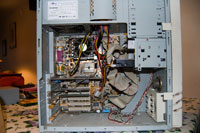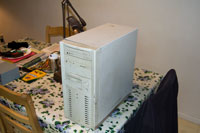Before we can go shopping, we need to see what we can reuse.

The motherboard and hard drive need to be replaced. The new motherboard will require a new processor and memory. So here's a list of what we can reuse:
- Mid-tower case
- CD-ROM
- CD-RW
- Floppy drive
- Internal wi-fi card
- Power supply
Usually, you would also have to change out the power supply to accommodate the new motherboard's increased electrical requirements. This power supply was replaced within the last two months, so that it can run the new configuration.
Time to go shopping. We can go online and local retailers. I prefer to go with local retailers, as returning items purchased online can be a hassle. But if you're sure that the possibility of returning the items is slim, it's a great way to get a bargain. The first item is a new motherboard, and what type of CPU (Intel or AMD)?
I'm going with Intel this time. O.K., an Intel processor may not be the most frugal way to go (AMD processors cost less), but for this system, I think it's the way to go. I went looking locally and found a Biostar G31-M7 for $50. It has an LGA775 processor socket. The array of processors available for it is broad.
I found an Intel Celeron 430 1.8 GHz (Retail box) on-line for $35. This is something I am relatively sure I will not have to return. Geek tip: Intel warranties are different for retail (boxed w/ cooling fan - 3 years) and wholesale (no box or cooling fan - 1 year). The price difference is the cost of a cooling fan. So unless you are going to overclock your processor (which requires more cooling than the standard fan provides and voids the warranty), go with the retail version.
I found a deal on memory locally. Got a Corsair twin pack of 2gb DDR2 PC-6400 memory for $50. It came with a $25 mail-in rebate, making the final cost $25 for 4GB of memory.
I also got the hard drive locally. It's a Western Digital 3200AAKS 320 GB SATA hard drive for $52. I could have gone with a smaller size to keep down the cost, but this is the time to think about storage requirements (now and future). The larger the drive, the less the cost per gigabyte.
The total cost at this point is $162 (if you get the feeling I'm not done yet, you'd be right). We have an Intel Celeron 430 running at 1.8 GHz on a Biostar G31-M7 motherboard with 4 GB's of memory. The system has been running on a preinstall environment for over 24 hours and passed several stress tests. So it's time to...

'Pimp my Box' (sorry MTV, just had to use it).
The next time I write, we'll start building this system and take a trip to Home Depot. (Note: I am going excessive at this point).
Upgrading your computer cheaply (part 3)
1d52ba26-7c91-4688-8b26-e62b5bd96208|0|.0|96d5b379-7e1d-4dac-a6ba-1e50db561b04